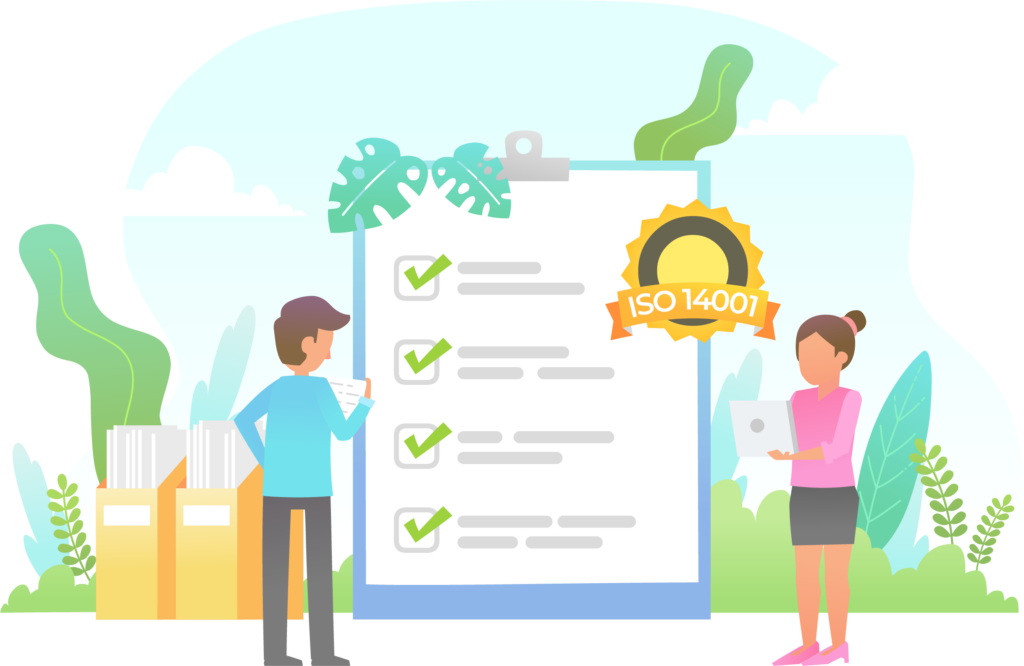ISO 14001 certification
All steps for a successful implementation

Table of contents
What is ISO14001?
ISO 14001 is an internationally recognized standard that provides guidelines for establishing and maintaining an effective Environmental Management System (EMS). It helps organizations identify, manage, and reduce their environmental impact, while promoting legal compliance and continuous improvement of environmental performance.
Implementing an EMS according to the ISO 14001 standards is a strategic step for organisations aiming to improve their environmental performance and meet legal obligations.
In this blog post, we’ll discuss the key steps for successfully implementing ISO 14001.
Start with a solid foundation
ISO 14001 is an environmental management system that helps organisations improve their environmental performance. Successful implementation requires an understanding of the standard, active involvement of management, and sufficient resources.
Employees from various departments form a team that guides the implementation process.
In addition, awareness and training of all employees are essential to create support throughout the organization.
Need help with ISO 14001 implementation?
Define the scope of the Environmental Management System
Clearly establish which processes and departments fall under ISO 14001. A well-defined scope enables efficient and manageable implementation.
Conduct a gap assessment with the ISO 14001 checklist
Analyse current processes and environmental performance. This “gap assessment” identifies what is already compliant and highlights areas for improvement. After implementation, this analysis is repeated to measure progress.
Create a tailored action plan
Based on the checklist, develop an implementation plan that includes specific tasks, deadlines, resources, and responsibilities.
The plan should follow the ‘Plan-Do-Check-Act’principe , ensuring the system supports continuous improvement and meets all ISO 14001 requirements.
Maintain continuous communication
Throughout the implementation process, regularly update employees on progress. Additional training may be needed to enhance the system’s effectiveness.
Document processes and procedures
Create the required documentation and procedures. Standard templates can serve as a base but must be tailored to the unique needs of your organization. Clearly distinguish between procedures (how tasks are performed) and records (evidence of actions taken).
The core of ISO 14001
ISO 14001 consists of ten chapters.
Here are the most important elements:
Chapter 4: Context of the organisation
Identify all relevant environmental factors and stakeholders. This helps develop effective policies and assess potential risks and opportunities.
Chapter 5: Leadership
Top management must define clear environmental policies and assign roles and responsibilities. This ensures structured implementation.
Chapter 6: Planning
Analyse key environmental issues and define measurable objectives. Evaluate the significance of environmental aspects and assess legal compliance.
Chapter 7: Support
Covers required competencies, training programs, communication flows (internal and external), and document control processes.
Chapter 8: Operation
Implementation of actions and improvements through procedures related to purchasing, waste management, suppliers, emergency preparedness, planning, etc. These provide structure and ensure proper data collection.
Chapter 9: Performance evaluation
Involves monitoring, measuring, analyzing, and evaluating data. Often includes specific KPIs, reviewed in management evaluations. Internal audits ensure effectiveness.
Chapter 10: Improvement
Based on evaluation, necessary changes must be made, including corrective and preventive actions. This is key to ISO 14001’s continuous improvement cycle.
Final steps toward certification
System implementation
Once preparation is complete, the EMS must be officially rolled out organisation-wide. Management and employees must be informed of new or updated processes, procedures, and records as outlined in the system.
Repeat the ISO 14001 checklist
Revisit the checklist to verify whether all requirements have been properly implemented. Any gaps can be identified and resolved in time.
Select an ISO 14001 certification body
Choose an independent certification body to evaluate the EMS. Start this process early to avoid delays in certification.
Internal audit
Conduct an internal audit as final preparation for certification. Include a management review to identify focus areas and improvements before the external audit.
Schedule the internal audit at least eight weeks in advance to allow time for corrective actions.
Corrective actions
Evaluate internal audit results. Address any non-conformities and implement improvements to prepare for a successful external audit.
External audit
An independent auditor will assess whether your EMS meets ISO 14001 requirements.
If successful, your organization will be awarded ISO 14001 certification. If not, you can often still reach compliance through a targeted action plan.
Commit to continuous improvement
Certification is not the end. Your EMS should be continuously evaluated and improved. This ensures ongoing compliance with ISO 14001 and contributes to better environmental management.
Conclusion
We have years of experience helping companies—from small businesses to large multinationals—achieve ISO 14001-certification. Need assistance with ISO 14001 preparation or implementation? Our team of environmental experts knows the standard inside out. We understand every organization is unique, so we offer customised solutions tailored to your specific needs.
We also offer support in preparing your company for ISO 9001 an ISO 45001 certification.
Feel free to contact us for a consultation.
Looking for clarity?
Prevom has the expertise you are looking for.
We will be happy to inform you about the possibilities!